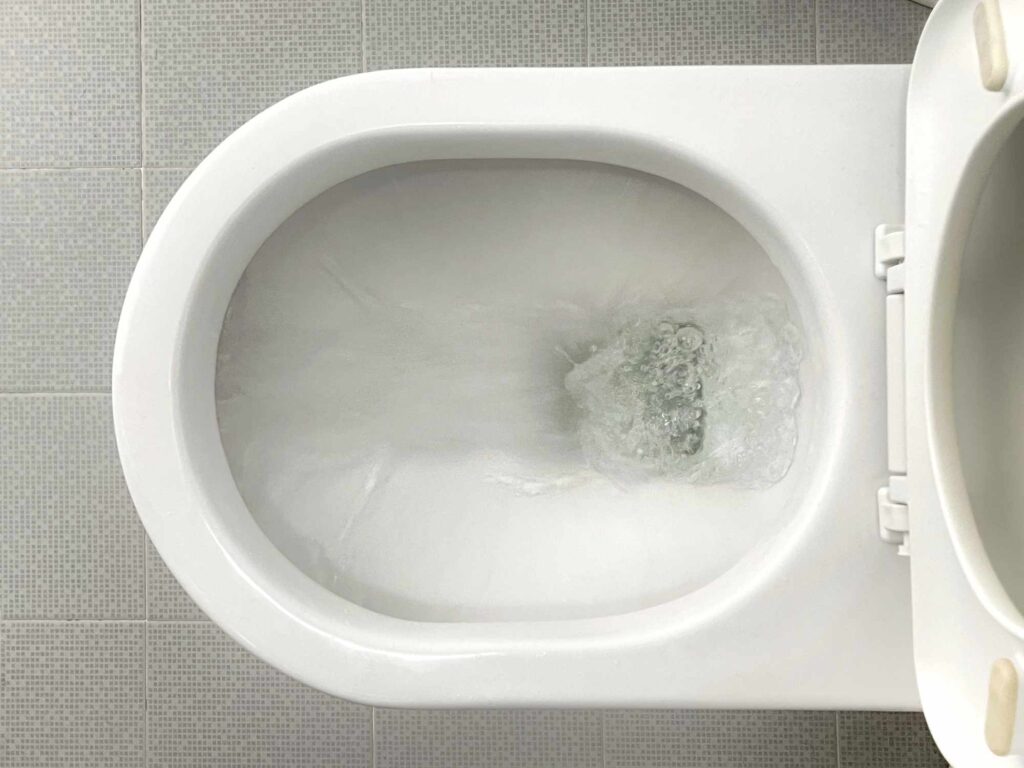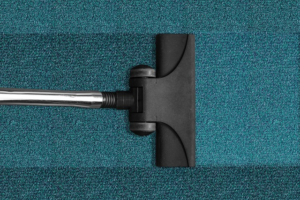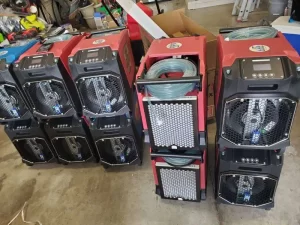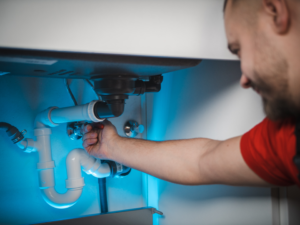It’s a little too easy for clogs to develop in your toilet. So, most homeowners will experience an overflowing toilet at least once in their life.
After a toilet backup, cleaning and sanitizing your bathroom are your main priorities. If you don’t have the proper tools, protective gear, or confidence you know what you’re doing, always turn to a professional who knows how to clean up after a toilet overflows before putting yourself in harm’s way.
Below, learn how to clean up after a toilet overflow scenario and other standard protocols to protect you and your family from future harm.
Immediate Action: What To Do After Your Toilet Overflows
As you’re waiting for a professional plumber to arrive, you can do a few things to minimize water damage from your overflowing toilet.
- Gear up: Find rubber, slip-resistant shoes to wear as you work, and wear rubber gloves and plastic goggles to protect yourself from bacteria contamination.
- Turn off the water supply: You’ll find a shut-off valve underneath the tank – turn it until the water flow stops. If turning the shut-off valve doesn’t stop water flow, you may need to lift off the toilet tank lid and pull up the float. If that also fails, turn off your main water supply line.
- Ventilate the area: If your bathroom has a ventilation fan, turn it on. Open your windows, too, and if you have an air filter, that’s even better— it can help pull out any harmful airborne particles.
DIY How To Mop Up Clean Toilet Overflow Properly
If you’re lucky, the water from an overflowing toilet will be clean. Otherwise, you’re in for a thoroughly gut-wrenching experience.
Generally, you’ll be dealing with human waste and sewage water containing harmful bacteria.
If you’re lucky, however, you can get started cleaning on your own.
Gear Up, Even In Clean Water
No matter how clean water may seem, there’s always a chance for bacterial contamination, especially when dealing with an overflowing toilet.
Remove Standing Water and Waste
After you shut off the water supply line and stop the overflow, mop up all the water covering your bathroom floor. If you have a wet-dry vacuum, switch it to wet mode and suck up what you can.
Setting up a fan or dehumidifier might also be beneficial to accelerate dry time.
It is important to mop up as much water as possible to prevent water from seeping below the floor, causing structural water damage and mold growth in other rooms of your house.
Set Up Your Work Area
Place an old towel around the toilet base to catch any overflow water while attempting to clear the clog.
Scoop out some of the remaining water, as well, at least a few inches. Try to clear water from the tank, too— as much as you can. If you have a wet vac, you can use that.
Have soap nearby in case you need to wash your hands.
Use the Right Plunger
There are two toilet plungers: You will either use a flange plunger or an accordion plunger.
“Flange” refers to the soft rubber cup of the plunger that folds out from the inside and fits well over curved toilet drains. The accordion plunger is made of hard plastic instead but is not very easy to use and can scratch the surface of your toilet.
Please note that there is a separate style of plunger for sinks. Do not cross-use plungers; this is unhygienic and inefficient.
Tips to Effectively Unclog the Toilet
- Don’t plunge at an angle
- Create suction by slowly pressing down
- Submerge the plunger, even if that means adding more water
- Inspect your plunger regularly for tears, cracking, or mold growth
- Never plunge after using toxic chemicals due to potential backsplash
What to Do if Plunging Isn’t Enough
If using your plunger doesn’t unclog the toilet, you can either try a snake, toilet auger, or call a plumber. A toilet drain snake can snag clogs and pull them out with small hooks. The other option is a toilet auger, which is in more of a spiral than a snake.
If you want to attempt this yourself, feed the snake slowly down the bowl and into the S-shaped trap. Apply pressure until you feel an obstruction.
Try to work the snake around the obstruction; you’ll know it’s working if a little water can drain through.
Make a saw-like motion while turning the snake (or twist the auger around a few times) so the hooks have a good chance to grab on and then ease the clog out.
Dump the debris into a mop bucket and repeat the process several times. If you think you got everything, turn the water back on and try to flush.
If you aren’t comfortable with this step, don’t have any luck, or still can’t flush after clearing what you could, it’s time to call a plumber.
Start Drying the Area, Including Walls and Cabinets
Old towels can help with excess water, and you can aim fans into the room to help circulate the air and dry up the remaining moisture.
You will want to be sure all the excess water is dried up so it doesn’t dilute your cleaning products and lead to more cleaning time.
Clean and Sanitize Your Bathroom
If you have a helper, one of you can focus on the clog while the other works on toilet overflow cleanup. If you are alone, the toilet is your priority since you might create more mess.
Whoever is cleaning should also wear gloves. It’s best to wear other protective gear as well, such as rubber boots or slip-resistant shoes and safety goggles. Plus, toilet water can be pretty gross, and you may want to use bleach while cleaning.
You can use several things to clean the different surfaces in your bathroom. Mixing one gallon of warm water with one cup of bleach is an easy disinfectant solution, or you can purchase a disinfectant cleaner.
If you want something less caustic, you can try mixing vinegar with hot water first.
Be sure to clean everything the toilet overflow touches, including your toilet bowl, toilet seat, and your bathroom floors.
Start with Your Bathroom Floor
Disinfect your floor first, then disinfect your shoes. This will sanitize the majority of the contaminated area and let you get down on your hands and knees to clean any surfaces like baseboards, the bottom of your tub and door, and any cabinetry.
Finally, go after any and all surfaces that came in touch with the water.
Special Considerations for Hardwood Floor
Hardwood flooring is a little harder to work with, as many disinfectants can cause damage. If you have a hardwood floor, keep specialized cleaning solutions on hand so you can grab them easily in an emergency.
Sanitizing Carpet When Your Toilet Overflows
Not all bathroom floors are tile. Some have hardwood or even carpet, depending on when the house was built. Unfortunately, water can have even worse effects on carpets.
Some homeowners love having rugs on top of their tile or hardwood bathroom floors.
Remove Excess Water
You won’t just be wiping up a small pond of standing water— it will soak into the fibers and likely spread across the entire floor.
Old towels and a wet-dry vac will be your best friend here. Remove as much water as possible, then wait for it to air dry.
Disinfect the Carpet
Use a disinfectant solution to clean the affected area. You probably want to avoid bleach since that can affect the coloring of your carpet.
Use a cleaning tool like a scrub brush to lift debris and dirt from deep within the fibers.
Let your disinfectant of choice sit for fifteen minutes, rinse with fresh water, and let it air dry.
Vacuum Thoroughly
Once dry, go over the carpet with your vacuum cleaner; a standard vacuum will work for this. You want to remove any dirt particles left over after sanitizing.
If you have a rug, vacuum both sides.
Consider an Inspection
If the water from your toilet overflow was particularly disgusting, it might have gotten down into the carpet pad.
If that’s the case, it must be ripped up and replaced.
If you aren’t sure, you can call a water damage restoration company to come inspect the area and give you a professional assessment.
Clean and Sanitize the Toilet
Apply toilet bowl cleaner to the inside and let it set while you work on outside surfaces. You want to clean the entirety of the toilet: base to bowl to tank to lid. Use a disinfectant or warm water mixed with vinegar.
Wipe down all hard surfaces. You can use a cloth cleaner like Clorox wipes or use an old rag with your preferred disinfectant. Sweep any debris like hair with paper towels and dispose of it properly. Don’t forget the toilet seat.
Once you have cleaned the entirety of the outside, the cleaner inside the bowl will have sat long enough. Use your toilet scrubber along the surface and then flush.
You can purchase a cleaner specifically for the inside of your tank. This will help disinfect the area if it is still full of water and keep your toilet clean for the next few weeks. If the tank is empty, wipe it down as you did outside before allowing it to refill.
Watch for Mildew or Mold Growth
Mold can set in within 24-48 hours of water damage. In the days following your overflow, keep an eye on your bathroom floor, walls, and furniture for any sign of moisture damage or growth.
If you see mildew, clean it with the appropriate solution for the surface; however, if you see mold— especially mold that looks black —call for professional mold remediation. Mold is toxic and dangerous to work with, so it is best left to the experts.

What Causes Toilet Overflows?
Knowing what leads to a problem can help you prevent it. Let’s take a look at some of the most common reasons for toilet overflow.
Old Pipes and Connections
The status of your plumbing plays a major role in how well things drain and flush. Older homes have metal pipes that can corrode and rust, weakening their connections. This breakdown in your pipes or sewer line can lead to a backup, causing the overflow.
General Failures
From broken handles to disconnected chains in your toilet tank, a toilet overflowing can simply be a sign you need to replace certain hardware.
Broken fixtures lead to a constant flow of water that will eventually spill out, whether from the toilet tank or the bowl.
Clogs In Your Trap, Drain Pipe, or Sewer Laterals
The S-shaped trap in your toilet helps keep sewer gases out of your bathroom, but it’s also prime real estate for clogs.
S-traps and pipes are also both vulnerable to being obstructed by non-flushable items like cotton balls or feminine products or by too much toilet paper.
You should also childproof your bathroom to avoid toddlers dropping small objects down the drain.
S-shaped traps can generally be cleared with a snake or auger, but drain pipes should be left to the professionals.
On the topic of clogs, sometimes the problem is outside your home. If your toilet overflows for no discernable reason and your bathroom starts to smell gross, there may be a clog in the sewer lateral between your home and the city.
This can push water through the sewer line and into basements or up through drains.
Low Flush Toilets
They’re great if you want to conserve water, but you have to be more careful.
Low-flush toilets have been more prone to clogs and backups. Newer models are working to improve this issue, but it’s not perfect yet.
Dealing With An Overflowing Toilet? Call Flood Kings!
Here at Flood Kings, our expert teams have over a decade of experience helping Nashville families repair and restore their homes after water damage from backed-up toilets, burst pipes, and more.
Flood Kings offers professional cleaning and restoration, doing everything possible to salvage your belongings. If you have a water emergency, call our line at any time, and we’ll send someone to help.








